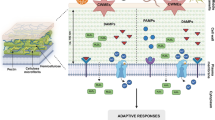Abstract
To throw light on the expression of ripening-related genes in prickly pear (Opuntia sp.) fruits and on the possible role of the gaseous hormone ethylene in nonclimacteric fruit ripening, cDNA fragments that showed high homologies with 1-aminocyclopropane-1-carboxylate (ACC) synthase and ACC oxidase cDNAs from other plants were cloned and partially characterized. Thus, the corresponding genes were accordingly named opaccs-1 and opacco-1, after Opuntia ACC synthase-1 and Opuntia ACC oxidase-1, respectively. Southern analysis suggests the presence of at least one copy of both genes, as well as other related homologous sequences in the Opuntia genome. Northern analysis of the opaccs-1 gene shows an enhanced expression in ripening fruit tissues, whereas opacco-1 expression is highly induced in ripe tissues with respect to the green fruits and mature cladodes. These results are in agreement with an active metabolic role of ethylene during nonclimacteric prickly pear fruit ripening. This is the first report on the analysis at the molecular level of ripening-related genes of the Opuntia genus.
Similar content being viewed by others
References
Nakatsuka A, Murachi S, Okunishi H, Shiomi S, Nakaino R, Kubo Y, Inaba A (1998) Differential expression and internal feedback regulation of 1-aminocyclopropane-1-carboxylate synthase, 1-aminocyclopropane-1-carboxylate oxidase, and ethylene receptor genes in tomato fruit during development and ripening. Plant Physiol 118: 1295–1305.
Bleecker AB, Kende H (2000) Ethylene: A gaseous signal molecule in plants. Annu Rev Cell Dev 16: 1–18.
Jiang Y, Fu J (2000) Ethylene regulation of fruit ripening: Molecular aspects. Plant Growth Regul 30: 193–200.
Fluhr R, Mattoo AK (1996) Ethylene–Biosynthesis and perception. Crit Rev Plant Sci 15: 479–523.
Porat R, Weiss B, Cohen L, Daus A, Goren R, Droby S (1999) Effects of ethylene and 1-methylcyclopropene on the postharvest qualities of “Shamouti” oranges. Postharv Biol Technol 15: 155–163.
Goldschmidt EE (1998) Ripening of citrus and other non-climacteric fruits: A role for ethylene? Acta Hortic 463: 335–340.
Alonso JM, Chamarro J, Granell A (1995) Evidence for the involvement of ethylene in the expression of specific RNAs during maturation of the orange, a non-climacteric fruit. Plant Mol Biol 29: 385–390.
Luo Y, Liu X (1994) Effects of ethylene on RNA metabolism in strawberry fruit after harvest. J Hortic Sci 69: 137–139.
Cazzonelli CI, Cavallaro AS, Botella JR (1998) Cloning and characterization of ripening-induced ethylene biosynthetic genes from non-climacteric pineapple (Ananas comosus) fruits. Austr J Plant Physiol 25: 513–518.
Mondragón-Jacobo C, Pérez-González S (1996) Native cultivars of cactus pear in Mexico. In: Janick J (ed), Progress in New Crops. Arlington: ASHS Press, pp 446–450.
Cantwell M (1991) Quality and postharvest physiology of “nopalitos” and “tunas.” In: Proceedings of the Second Annual Texas Prickly Pear Conference, Texas Prickly Pear Council, McAllen, Texas, pp 60–64.
Lakshminarayana S, Estrella IB (1978) Postharvest respiratory behavior of tuna (prickly pear) fruit (Opuntia robusta Mill.). J Hortic Sci 53: 327–330.
Lakshminarayana S, Alvarado S, Sosa L, Barrientos F (1979) The development and postharvest physiology of the fruit of cactus pear (Opuntia amyclaea T.). In: Inglett GE, Charalambous G (eds), Tropical Foods: Chemistry and Nutrition, Vol 1. New York: Academic Press, pp 69–93.
Jones JDG, Dunsmuir P, Bedbrook J (1985) High level expression of introduced chimeric genes in regenerated transformed plants. EMBO J 4: 2411–2418.
Sambrook J, Fritsch EF, Maniatis T (1989) Molecular Cloning: A Laboratory Manual, 2nd edn. New York: Cold Spring Harbor Laboratory Press.
Doyle JJ, Doyle JL (1990) Isolation of plant DNA from fresh tissue. Focus 12: 13–15.
Park KY, Drory A, Woodson WR (1992) Molecular cloning of an 1-aminocyclopropane-1-carboxylate synthase from senescing carnation flower petals. Plant Mol Biol 18: 377–386.
Wang H, Woodson WR (1991) A flower senescence-related mRNA from carnation shares se-quence similarity with fruit ripening-related mRNAs involved in ethylene biosynthesis. Plant Physiol 96: 1000–1001.
Author information
Authors and Affiliations
Rights and permissions
About this article
Cite this article
Collazo-Siqués, P., Valverde, M.E., Paredes-López, O. et al. Expression of Ripening-Related Genes in Prickly Pear (Opuntia sp.) Fruits. Plant Foods Hum Nutr 58, 317–326 (2003). https://doi.org/10.1023/B:QUAL.0000040286.28359.76
Issue Date:
DOI: https://doi.org/10.1023/B:QUAL.0000040286.28359.76




